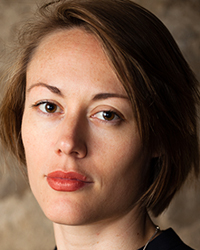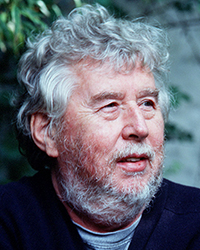 The latest concert given by Birmingham Contemporary Music Group, last Sunday, was an extended celebration for the 85th birthday of Britain’s most radical musical octogenarian, Harrison Birtwistle. In fact, the occasion was marked by not one but two back-to-back concerts, the first of which gave prominence to performers taking part in the ensemble’s NEXT scheme, coaching early-career instrumentalists. In addition to eight works by Birtwistle, the concerts included music by Rebecca Saunders and Australian composer Lisa Illean.
The latest concert given by Birmingham Contemporary Music Group, last Sunday, was an extended celebration for the 85th birthday of Britain’s most radical musical octogenarian, Harrison Birtwistle. In fact, the occasion was marked by not one but two back-to-back concerts, the first of which gave prominence to performers taking part in the ensemble’s NEXT scheme, coaching early-career instrumentalists. In addition to eight works by Birtwistle, the concerts included music by Rebecca Saunders and Australian composer Lisa Illean.
 Saunders‘ a visible trace entirely lived up to the paradox of its title, combining tangibility and clarity with hard-to-quantify, half invisible ideas. At first, this duality suggests an elusive music, seemingly weak and frail, but the piece requires an adjustment on our part to its sense of scale. One might almost call it a ‘quantum music’ – as such, eruptions that periodically flare up feel not only hugely significant but, literally, huge. As for the rest, BCMG managed to maintain a mesmeric miniature soundworld, sounds hanging, sliding and coalescing in the air before collapsing either under gravity or their own weight. Most impressive was the way the ensemble handled the work’s gradual increase in volatility, making subsequent lulls and softer periods become tense and precarious, capable of shattering or exploding at any moment. Our focus of attention shifts constantly between surface details and longer-term activity, all the while caught between poles of frailty and ferocity. There was an even a sense, which i’m not sure i’ve heard in performances of this piece before, of a possible dronal firmament beneath the music, a fundamental from which everything had originally sprang. The more i reflect on it, i realise how effective this performance was, offering new insights into music that can sometimes sound obstinate and aloof.
Saunders‘ a visible trace entirely lived up to the paradox of its title, combining tangibility and clarity with hard-to-quantify, half invisible ideas. At first, this duality suggests an elusive music, seemingly weak and frail, but the piece requires an adjustment on our part to its sense of scale. One might almost call it a ‘quantum music’ – as such, eruptions that periodically flare up feel not only hugely significant but, literally, huge. As for the rest, BCMG managed to maintain a mesmeric miniature soundworld, sounds hanging, sliding and coalescing in the air before collapsing either under gravity or their own weight. Most impressive was the way the ensemble handled the work’s gradual increase in volatility, making subsequent lulls and softer periods become tense and precarious, capable of shattering or exploding at any moment. Our focus of attention shifts constantly between surface details and longer-term activity, all the while caught between poles of frailty and ferocity. There was an even a sense, which i’m not sure i’ve heard in performances of this piece before, of a possible dronal firmament beneath the music, a fundamental from which everything had originally sprang. The more i reflect on it, i realise how effective this performance was, offering new insights into music that can sometimes sound obstinate and aloof.
 The same unfortunately couldn’t be said for Saunders’ Molly’s Song 3 – Shades of Crimson, which felt strangely distant, impassioned but elusive, alienated and alienating. It wasn’t helped by the fact that the performance was at times a little clunky, but i can’t help feeling the players’ interpretation went too far in emphasising the withdrawn, stubborn nature of the material, rendering it a little too dazed and stupefied for its own good. This meant that the work’s music box twist, its presence as wonderfully weird as ever, acted more like light relief in an otherwise leaden environment. Lisa Illean‘s Cantor sounded distant for a different and not so alienating reason: it was as if soprano Alice Rossi and BCMG were enclosed within a hermetically-sealed sphere. This wasn’t a bad thing, per se, and it did nothing at all to diminish the work’s sense of reverie, Rossi caught up in the words (adapted from a text by Willa Cather). At its best, in penultimate section ‘Closing’, Illean created a kind of humid, undemonstrative passion and bliss. This was countered somewhat by an increasingly urgent question as to whether the words were shaping the music or being shaped by the music, resulting in a reduced sense of agency in the singer. The conclusion was nice, almost threatening to yield to a Romantic sensibility before its pitches slid haphazardly, erasing pretty much everything.
The same unfortunately couldn’t be said for Saunders’ Molly’s Song 3 – Shades of Crimson, which felt strangely distant, impassioned but elusive, alienated and alienating. It wasn’t helped by the fact that the performance was at times a little clunky, but i can’t help feeling the players’ interpretation went too far in emphasising the withdrawn, stubborn nature of the material, rendering it a little too dazed and stupefied for its own good. This meant that the work’s music box twist, its presence as wonderfully weird as ever, acted more like light relief in an otherwise leaden environment. Lisa Illean‘s Cantor sounded distant for a different and not so alienating reason: it was as if soprano Alice Rossi and BCMG were enclosed within a hermetically-sealed sphere. This wasn’t a bad thing, per se, and it did nothing at all to diminish the work’s sense of reverie, Rossi caught up in the words (adapted from a text by Willa Cather). At its best, in penultimate section ‘Closing’, Illean created a kind of humid, undemonstrative passion and bliss. This was countered somewhat by an increasingly urgent question as to whether the words were shaping the music or being shaped by the music, resulting in a reduced sense of agency in the singer. The conclusion was nice, almost threatening to yield to a Romantic sensibility before its pitches slid haphazardly, erasing pretty much everything.
 In the music by Harrison Birtwistle, while his birthday might seem like a reasonable enough theme in and of itself, what connected the pieces most of all was the notion of relationship, specifically various forms of duality. In both The Woman and the Hare and new work …when falling asleep, receiving its world première, the duality is manifest in a pair of vocalists, Rossi being joined for these pieces by Simone Leona Hueber. In …when falling asleep, the relationship is—well, arguably there is no relationship, beyond the fact that both are present in the same place at the same time. They articulated two separate strands of sentiment, one (sung) elegant, one (spoken) forceful, with the only obvious point of connection the audience itself, being the focal point for both voices. If Birtwistle was intending to split the ensemble to align themselves with either of the voices, that effect was lost in this performance, with pretty much the entire weight of the music sounding connected to Rossi, Hueber coming across like an intruder, not affiliated to anything or anyone else. Very weird. By contrast, in The Woman and the Hare the two voices acted as contrasting but sympathetic twin aspects of the same expressive voice: Rossi lyrical, lingering over each word; Hueber brisk, almost prosaic. Here, the ensemble’s role felt reversed, most closely aligned to Hueber’s more lengthy narrative. While this left Rossi’s notes floating above everything in a way that, at times, seemed practically indifferent, her music was clearly impelled by and echoed the attitude of Hueber and the ensemble, reinforcing an overall sense of continuity and unity.
In the music by Harrison Birtwistle, while his birthday might seem like a reasonable enough theme in and of itself, what connected the pieces most of all was the notion of relationship, specifically various forms of duality. In both The Woman and the Hare and new work …when falling asleep, receiving its world première, the duality is manifest in a pair of vocalists, Rossi being joined for these pieces by Simone Leona Hueber. In …when falling asleep, the relationship is—well, arguably there is no relationship, beyond the fact that both are present in the same place at the same time. They articulated two separate strands of sentiment, one (sung) elegant, one (spoken) forceful, with the only obvious point of connection the audience itself, being the focal point for both voices. If Birtwistle was intending to split the ensemble to align themselves with either of the voices, that effect was lost in this performance, with pretty much the entire weight of the music sounding connected to Rossi, Hueber coming across like an intruder, not affiliated to anything or anyone else. Very weird. By contrast, in The Woman and the Hare the two voices acted as contrasting but sympathetic twin aspects of the same expressive voice: Rossi lyrical, lingering over each word; Hueber brisk, almost prosaic. Here, the ensemble’s role felt reversed, most closely aligned to Hueber’s more lengthy narrative. While this left Rossi’s notes floating above everything in a way that, at times, seemed practically indifferent, her music was clearly impelled by and echoed the attitude of Hueber and the ensemble, reinforcing an overall sense of continuity and unity.
Some of the most engaging instances of the duality i mentioned occurred in the first concert, in a series of smaller-scale duets. Not so much in Pulse Sampler, though, performed on this occasion by oboist Melinda Maxwell and percussionist Julian Warburton, premièring a revised version of the score that, supposedly, elaborates the percussion part. Whatever changes Birtwistle had made didn’t change the primary problem with this piece: namely what it is about the percussion’s shifting temporal basis that is so appealing to the oboist to dance rings around it. While the performance itself was superb, Maxwell nonetheless came across a bit like a an obsessed groupie, blind to the dry and incredibly dull metrics banged out by Warburton, and just desperately wanting to be around them. Less well-defined in its relationship but far more involving was Duet 4, brilliantly performed by flautist Gavin Stewart and violinist Alicja Humeniuk. Was it a conversation? Was the way they talked over each other combative or were they interlocking? Are they in sympathy with each other – could it even be a game? Duet 4 posed all of these questions in just two minutes of music, and i think it answered all of them the same way: yes. A less equal duality emerged in Linoi, an early work of Birtwistle’s for clarinet and piano composed as far back as 1968. Raymond Brien’s clarinet assumed dominance in extremely slow-moving, quiet (sometimes almost inaudible) material, sparsely punctuated by Joe Howson on the strings of his piano, exhibiting the same kind of obsessed focus – though the opposite level of response – as the oboe in Pulse Sampler. Birtwistle gradually coaxes more from the clarinet, culminating in an absolute slew of outpouring, peppered with confirmatory accents from the piano. But there was nothing comfortable about this climax: the clarinet’s subsequent withdrawal inward sounded like a direct response to its excess and exposure, leading the instrument to return with its piano familiar to the low, soft, dark spaces where it feels most comfortable. It was a mesmerising performance of an evocative and highly immediate piece, showing that size isn’t everything, that early-career players can deliver truly outstanding performances, but above all testifying to the fact that Harrison Birtwistle’s music, new and old, continues to defy, delight, disorient and dazzle us in ways that are entirely unique and deserve to be loudly and regularly celebrated.

Sounds like a fascinating concert. I agree that Birtwistle’s music deserves to be celebrated “loudly and regularly” – personally I have become more and more fascinated by his work over the past couple of years (thanks in no small part to this blog). And I find that his smaller-scale music can be more engaging on first listen than some of those mammoth orchestral works.
I wonder if you’ve read his book of conversations with Fiona Maddocks? There were plenty of fascinating insights into his creative process. The quote at the start seemed particularly apt – he said he wanted to write music that would “retain its mysteries and never become familiar”, which seems like a perfect description of his work.